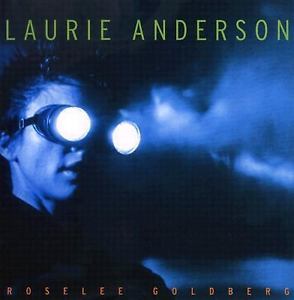RoseLee Goldberg: Laurie Anderson (2000)
Filed under book | Tags: · art, art criticism, avant-garde, music, music criticism, musical instruments, performance, performance art, storytelling, technology

“Laurie Anderson is one of the most acclaimed and innovative performance artists and musicians working today. The entire scope of her career is celebrated in this volume, from her early art works and performances in the 1970s, to her rise to prominence in the 1980s with her single O Superman, her portrait of the United States, and her breakthrough album Strange Angels; to her interactive Web site called The Green Room, a CD-ROM titled Puppet Motel, and her production Songs and Stories from Moby Dick, an electronic opera that is based on Herman Melville’s epic novel and includes new inventions, such as the Talking Stick.
With insightful text and more than 300 illustrations, author RoseLee Goldberg, a leading authority on performance art, explores aspects of Anderson’s work of the past three decades, illuminating Anderson’s creative process; her enduring interests in storytelling and in technology; her collaborations with such avant-garde figures as author William Burroughs, monologist Spalding Gray, and rock star Lou Reed; the social and political contexts that have shaped her art; and the critical and popular response it has received. In addition to surveying Anderson’s work chronologically, Goldberg devotes special sections of the book to Anderson’s inventions and body instruments, such as her Headlight Glasses and Screen Dress; her stage sets; her many violins, including the Tape Bow Violin and the Viophonograph; her scores; and her videos. The lyrics to many of Anderson’s songs are included, as are lengthy excerpts from many of her performances, stories, and other writings.”
Publisher Harry N. Abrams, New York, 2000
ISBN 0810935821
204 pages
Review: Eric P. Nash (NYT Books, 2000).
PDF (46 MB, no OCR)
Comment (0)Writing and Unwriting (Media) Art History: Erkki Kurenniemi in 2048 (2015)
Filed under book | Tags: · archive, art, media art, memory, music, technology

“Over the past forty years, Finnish artist and technology pioneer Erkki Kurenniemi (1941-2017) was a composer of electronic music, experimental filmmaker, computer animator, roboticist, inventor, and futurologist. Kurenniemi was a hybrid—a scientist-humanist-artist. Relatively unknown outside Nordic countries until his 2012 Documenta 13 exhibition, ”In 2048,” Kurenniemi may at last be achieving international recognition. This book offers an excavation, a critical mapping, and an elaboration of Kurenniemi’s multiplicities.
The contributors describe Kurenniemi’s enthusiastic, and rather obsessive, recording of everyday life and how this archiving was part of his process; his exploratory artistic practice, with productive failure an inherent part of his method; his relationship to scientific and technological developments in media culture; and his work in electronic and digital music, including his development of automated composition systems and his “video-organ,” DIMI-O. A “Visual Archive,” a section of interviews with the artist, and a selection of his original writings (translated and published for the first time) further document Kurenniemi’s achievements. But the book is not just about one artist in his time; it is about emerging media arts, interfaces, and archival fever in creative practices, read through the lens of Kurenniemi.”
Edited by Joasia Krysa and Jussi Parikka
Foreword by Erkki Huhtamo
Publisher MIT Press, 2015
ISBN 9780262029582, 0262029588
xxviii+340 pages
Reviews: Amanda Egbe (Leonardo, 2016), Alessandro Ludovico (Neural, 2016).
PDF (5 MB)
Comment (0)Lucie Vágnerová: Sirens/Cyborgs: Sound Technologies and the Musical Body (2016)
Filed under thesis | Tags: · body, cyborg, electronic music, feminism, gender, music, sound art, technology, women
“This dissertation investigates the political stakes of women’s work with sound technologies engaging the body since the 1970s by drawing on frameworks and methodologies from music history, sound studies, feminist theory, performance studies, critical theory, and the history of technology. Although the body has been one of the principal subjects of new musicology since the early 1990s, its role in electronic music is still frequently shortchanged. I argue that the way we hear electro-bodily music has been shaped by extra-musical, often male-controlled contexts. I offer a critique of the gendered and racialized foundations of terminology such as “extended,” “non-human,” and “dis/embodied,” which follows these repertories. In the work of American composers Joan La Barbara, Laurie Anderson, Wendy Carlos, Laetitia Sonami, and Pamela Z, I trace performative interventions in technoscientific paradigms of the late twentieth century.
The voice is perceived as the locus of the musical body and has long been feminized in musical discourse. The first three chapters explore how this discourse is challenged by compositions featuring the processed, broadcast, and synthesized voices of women. I focus on how these works stretch the limits of traditional vocal epistemology and, in turn, engage the bodies of listeners. In the final chapter on musical performance with gesture control, I question the characterization of hand/arm gesture as a “natural” musical interface and return to the voice, now sampled and mapped onto movement. Drawing on Cyborg feminist frameworks which privilege hybridity and multiplicity, I show that the above composers audit the dominant technoscientific imaginary by constructing musical bodies that are never essentially manifested nor completely erased.”
PhD Dissertation
Publisher Graduate School of Arts and Sciences, Columbia University, 2016
Advisor: Ellie M. Hisama
242 pages

